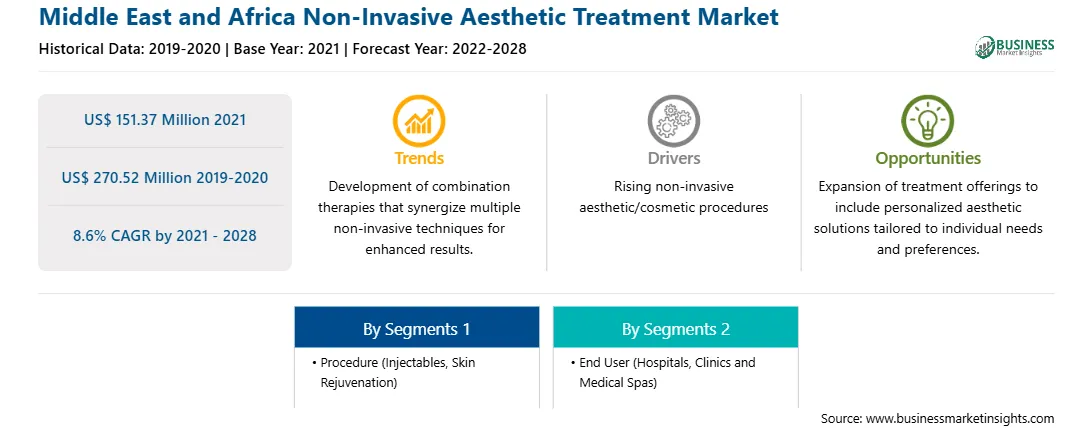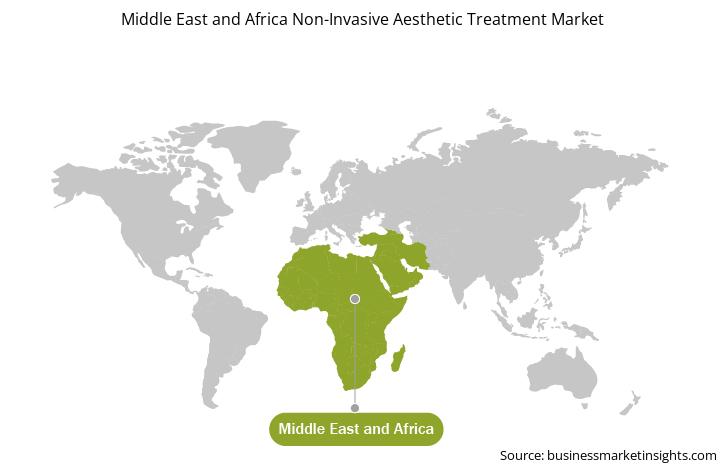Non-invasive or non-surgical aesthetic treatment refers to the aesthetic procedures that does not require any kind of surgical incision. Sometimes, minimally invasive surgeries are also considered as non-surgical procedures. Some of the commonly conducted non-invasive aesthetic treatment includes botulinum toxin injection, chemical peels, non-surgical laser treatment, and microdermabrasion amongst other.

Strategic insights for the Middle East and Africa Non-Invasive Aesthetic Treatment provides data-driven analysis of the industry landscape, including current trends, key players, and regional nuances. These insights offer actionable recommendations, enabling readers to differentiate themselves from competitors by identifying untapped segments or developing unique value propositions. Leveraging data analytics, these insights help industry players anticipate the market shifts, whether investors, manufacturers, or other stakeholders. A future-oriented perspective is essential, helping stakeholders anticipate market shifts and position themselves for long-term success in this dynamic region. Ultimately, effective strategic insights empower readers to make informed decisions that drive profitability and achieve their business objectives within the market.

| Report Attribute | Details |
|---|---|
| Market size in 2021 | US$ 151.37 Million |
| Market Size by 2028 | US$ 270.52 Million |
| Global CAGR (2021 - 2028) | 8.6% |
| Historical Data | 2019-2020 |
| Forecast period | 2022-2028 |
| Segments Covered |
By Procedure
|
| Regions and Countries Covered | Middle East and Africa
|
| Market leaders and key company profiles |
The geographic scope of the Middle East and Africa Non-Invasive Aesthetic Treatment refers to the specific areas in which a business operates and competes. Understanding local distinctions, such as diverse consumer preferences (e.g., demand for specific plug types or battery backup durations), varying economic conditions, and regulatory environments, is crucial for tailoring strategies to specific markets. Businesses can expand their reach by identifying underserved areas or adapting their offerings to meet local demands. A clear market focus allows for more effective resource allocation, targeted marketing campaigns, and better positioning against local competitors, ultimately driving growth in those targeted areas.

The Middle East and Africa non-invasive aesthetic treatment market is expected to reach US$ 270.52 million by 2028 from US$ 151.37 million in 2021; it is estimated to grow at a CAGR of 8.6% from 2021 to 2028. The growth of the market is attributed to a few key driving factors such as surging awareness about cosmetic procedures among consumers, availability of technologically advanced products in aesthetics, and proliferating medical tourism. However, clinical risks and complications associated with medical aesthetic procedures are hindering the market growth.
Non-invasive aesthetic treatments have gained popularity in the past few years due to advantages such as minimal downtime, no scars, low cost, and less complications. The popularity and acceptance of these procedures is mainly attributed to their non-invasiveness. Besides, it has been proved that the accuracy rate of minimally invasive surgeries is greater than that of open surgeries. Moreover, non-invasive treatments are gaining traction due to high preference for less downtime post treatment. Several government initiatives are helping in creating awareness regarding non-invasive aesthetic procedures among people. Therefore, the growing awareness regarding non-invasive aesthetic treatment procedures is boosting the growth of the Middle East and Africa non-invasive aesthetic treatment market. Several manufacturers are working on advanced non-invasive aesthetic treatment products. In October 2020, Alma launched its latest Alma Hybrid platform, designed to explore multiple possibilities of using ablative, non-ablative, and thermal treatments, along with testing their synergistic impact, on skin rejuvenation and scar revision. Therefore, the availability of user-friendly, technologically advanced non-invasive aesthetic treatment products is fuelling the market growth.
Socio–economic condition in Middle East countries has been widely affected by the COVID–19 pandemic. In addition, the lockdown has hindered the non-emergency medical services in the region, which has somehow adversely affected the aesthetic sectors. Saudi Arabia and the UAE are emerging as aesthetic destinations in the region. However, they are dependent on the foreign nations for the resources; therefore, the aesthetic industry has faced a negative impact and is expected to experience the same in the following few years. This is likely to have negative influence on the non-invasive aesthetic treatment market during the forecast period.
The Middle East and Africa non-invasive aesthetic treatment market, based on procedure, is segmented into injectables, skin rejuvenation, and others. The injectables segment held the largest share of the market in 2020, and the market for the same segment is expected to grow at the fastest rate during the forecast period.
The Middle East and Africa non-invasive aesthetic treatment market, by end user, is segmented into hospitals, clinics and medical spas, and others. The hospitals segment held the largest share of the market in 2020. Also, the same segment is anticipated to register the highest CAGR in the market during the forecast period.
A few of the primary and secondary sources associated with this report on the Middle East and Africa non-invasive aesthetic treatment market are the Emirates Conformity Assessment Scheme (SCAS), Emirates Standardization and Meteorological Authority (ESMA) and Dubai Health Authority (DHA).
The Middle East and Africa Non-Invasive Aesthetic Treatment Market is valued at US$ 151.37 Million in 2021, it is projected to reach US$ 270.52 Million by 2028.
As per our report Middle East and Africa Non-Invasive Aesthetic Treatment Market, the market size is valued at US$ 151.37 Million in 2021, projecting it to reach US$ 270.52 Million by 2028. This translates to a CAGR of approximately 8.6% during the forecast period.
The Middle East and Africa Non-Invasive Aesthetic Treatment Market report typically cover these key segments-
The historic period, base year, and forecast period can vary slightly depending on the specific market research report. However, for the Middle East and Africa Non-Invasive Aesthetic Treatment Market report:
The Middle East and Africa Non-Invasive Aesthetic Treatment Market is populated by several key players, each contributing to its growth and innovation. Some of the major players include:
The Middle East and Africa Non-Invasive Aesthetic Treatment Market report is valuable for diverse stakeholders, including:
Essentially, anyone involved in or considering involvement in the Middle East and Africa Non-Invasive Aesthetic Treatment Market value chain can benefit from the information contained in a comprehensive market report.